
The second day of our trip in Iceland started with a great breakfast in the kitchen in our guest house. The first site in our itinerary for the day was the DC Plane wreck site which has its rusting shell laying on haunting black sands. Frankly, as this is not a natural attraction I would not recommend visiting it. As the plane wreck was featured in Gerua song from Dilwale starring Shah Rukh and Kajol, it was on the bucket list of several of our team members.

To reach DC Plane Wreck site requires a walk from the ring road, as driving over the sands is considered to be driving off-road, and incredibly heavy fines are attached to this offence. A recently built car park by the main road allowed us to leave our vehicles and proceed to the wreck, taking approximately two hours. It’s also now possible to take a shuttle bus out to the plane wreck. The bus runs regularly and can be pre-booked in advance. We decided to walk.

As this is not a natural attraction, nor is it a permanent feature, so Icelanders in the past have not been too concerned about visitors climbing it for photographs. However, there is now a sign from the owner of the land stating that climbing on the plane is not allowed, and this is hardly respected by the selfie-obsessed crowd there. When we reached the place was swarming with pretty rude tourists. The recent tourism boom has worse affected many of the great tourist spots in Iceland, and this is one of them. I have erased most of the tourists from the subsequent pictures by using multiple captures taken using a tripod.
Here is how you eliminate people from tourists spots. In photoshop load several sequential photos as layers, auto-align these layers, convert all the aligned images into one smart object and then apply the median stack mode to the smart object. That will remove all the tourists who are moving leaving out those who remained static. Those you need to remove individually using content-aware fill.

Here I have tried to make the gloomy crash interesting by doing a zoom burst on the plane wreck.

The aircraft, a Douglas R4D-8, a Super DC-3, crashed into Sólheimasandur on Wednesday, November 21st, 1973, at around 14:00 as reported by the Aviation Safety Network. It was flying from Höfn in Iceland’s east coast and onboard were seven crew members.No one is quite sure why the plane crashed, with several theories flying about. No one was injured in the crash. The forced landing was made on an icy river by the coast, and though the ice broke, the plane didn’t sink.
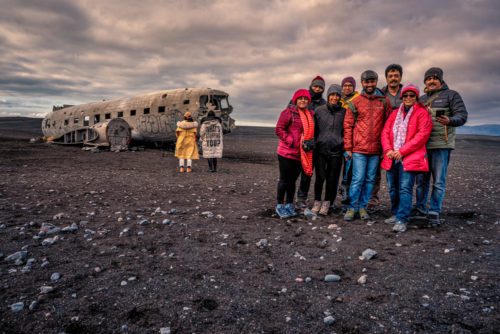
Here is our group shot, I used the same technique of removing tourists, but left two of them. The statement “What’s Stopping You” on her jacket is appropriate for all those who are afraid to venture out. In the years since its rocky landing, the DC Plane Wreck has borne the brunt of Iceland’s tempestuous weather; heavy rainfall, freezing and powerful gales. Today, the aircraft’s wings are no longer attached, and it has only half a tail (rumours say that a local farmer cashed in on the tail long ago.) It is not expected that the plane wreck will be there forever. Sólheimasandur is a glacial outwash plain, meaning when there is an eruption underneath the glacier Mýrdalsjökull, there is a definite chance that floodwater could wash it away. Mýrdalsjökull covers Katla, one of the country’s most explosive and regular volcanoes.
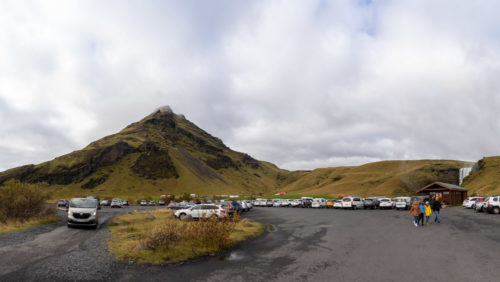
Our next stop was Skógafoss, one of Iceland’s biggest waterfalls with an astounding width of 25 meters and a drop of 60 meters. Located on the Skógá river, this mighty cascade is clearly visible from Route 1. As you can see the parking lot was filled with tourists, even though we were at the fag end of the tourist season.
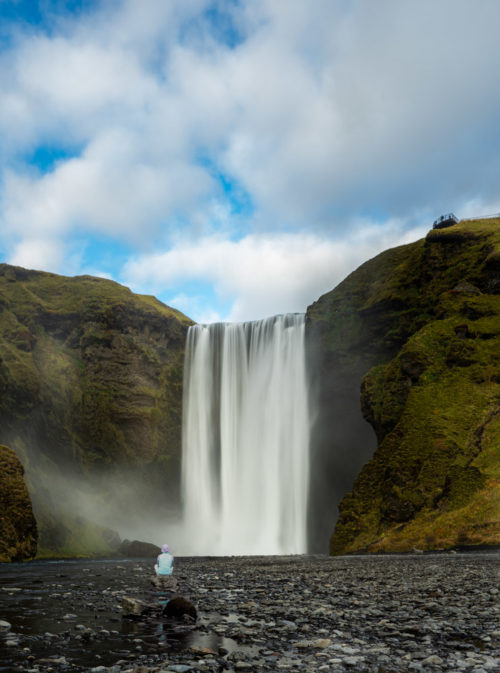
The land underneath the waterfall is very flat, allowing visitors to walk right up to the wall of water. Since one of the tourists was sitting on a rock and meditating I left her alone and erased the rest of the crowd using Photoshop magic 🙂

Ideally, very early morning or a late evening is the best time to get the best of this waterfall. Skógafoss can also be viewed from the top as a steep staircase leads to an observational platform above the cascade. We decided not to climb to the top. Trying to photograph the waterfall was difficult as there was a great curtain of tourist who wanted to capture this waterfall.
Skogafoss is a waterfall in the south of Iceland at the cliffs of the former coastline. After the coastline had receded seaward (it is now at a distance of about 5 kilometres (3.1 miles) from Skogar village), the former sea cliffs remained. Skogafoss is unique because the waterfall comes directly from two glaciers, Eyjafjallajokull and Myrdalsjokull.

According to legend, Þrasi Þórólfsson, one of the first Viking settlers in the area, who by some accounts was a giant. Folklore states that before his death in 900 AD, Þrasi buried a chest filled with gold in a cave behind Skógafoss waterfall. Many attempts were made to retrieve the chest after Þrasi’s death, and years later, locals managed to grasp a ring on the side of the chest. As they pulled, the ring broke off, and the treasure was lost forever. The ring was then given to the local church before it made its way to the museum.

On the southern Ring Road, near Skógafoss, sits the curious site of Rútshellir—a man-made cave carved into a huge chunk of rock. Rútshellir (Rútur’s Cave) is said to be the oldest extant man-made residence in Iceland. The name derives from a certain Rútur who is supposed to have lived there in olden times, and the cave was inhabited over the centuries.

The cave is mentioned in the Register of Estates compiled in 1714 by Árni Magnússon and Páll Vídalín, and again in the Travel Book of Eggert Ólafsson and Bjarni Pálsson in 1756, and in 1818, it was recorded in a register of archaeological sites by the Rev. Ólafur Pálsson of Eyvindarhólar. In 1936 the cave was studied by German scientists sent by the Nazi authorities to examine sites of heathen temples in Iceland, inspired by the Nazis’ admiration for Old Norse culture.

The cave is entered via a sheep shed which was built in front of it in the early 20th century. The cave is about 15 metres long and 2.5 metres in height. It is 5 metres across at its widest point. The main cave leads to a smaller annexe. There are many traces of human habitation in the cave, such as signs of timber structures within the cave, relics of black smithery (a slack tub in the floor for quenching hot iron), etc.

Our last destination of the day was very close to our guest house – Seljalandsfoss. The route back from Skógafoss was wonderful. Check the landscape near Ásólfsskáli.

Seljalandsfoss is a waterfall that can be fully encircled, situated on the South Coast of Iceland with a drop of 60 metres (200 feet). Due to the waterfall’s close proximity to the Ring Road and impressive natural features, it is one of the country’s most famous and visited falls. Majestic and picturesque, it is one of the most photographed features in all of Iceland.
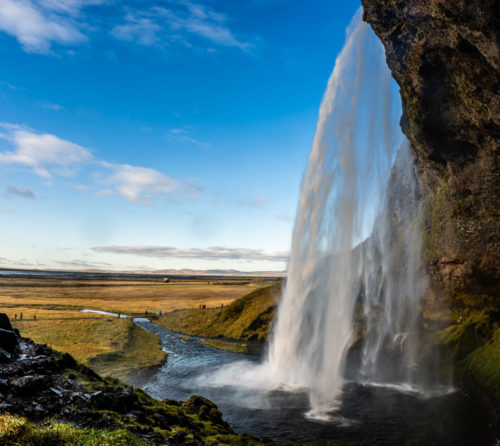
Seljalandsfoss waterfall, part of the river Seljalandsá, has its origins underneath the glacier Eyjafjallajökull. The volcano beneath this ice cap was the one that erupted in 2010 and caused havoc at airports across Europe. The cascade of the falls is relatively narrow but falls from a tall cliff that once marked the country’s coastline, the sea is now located across a stretch of lowlands and is visible from the site. Seljalandsfoss in winter obtains an entirely new allure for visitors to the South Coast of Iceland.

The most distinguishing feature of Seljalandsfoss is a pathway that stretches around it. The cliffs behind the falls have a wide cavern, and rocks and paths allow guests to fully encircle it in summer. Though a mesmerising opportunity, visitors should be prepared to get dampened due to the perpetual mist of the falls, which also tends to make the rocks of the pathway slippery.
It was getting dark, we went to nearby town Hella for our dinner and next day’s supplies and returned back to our guesthouse for great night sleep. See you in the next part of the blog.

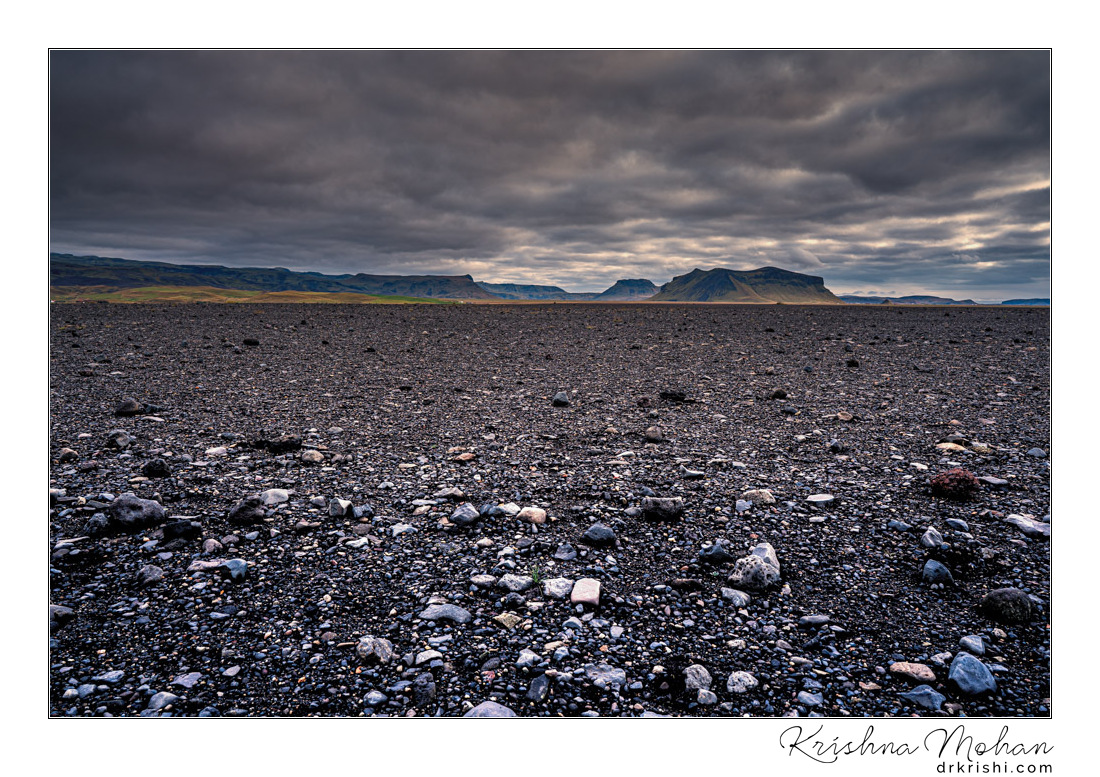
Iceland is just amazing! I was there 2015 and 2016. May return next year. Thank you so much for those awesome pictures! Love it. Keep up the good work!